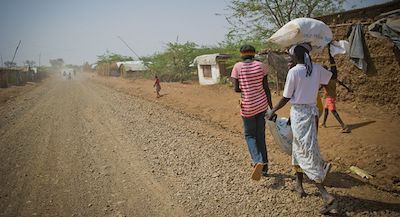How Can Chatbots Help Us Respond to Humanitarian Crisis?
At the moment, The World Food Programme (WFP) and the wider humanitarian system are #FightingFamine in four countries. In Somalia, Yemen, North-Eastern Nigeria and South Sudan 20 million people are on the brink of starvation. Our recent study “At the Root of Exodus” found that high levels of food insecurity lead to higher levels of migration across borders; UNHCR estimates that there are 65.6 million people forcibly displaced worldwide. The stakes are high, we need all the information we can get.
 World Food Programme. Photo WFP/Rein SkullerudBased on our previous experiences and secondary sources, we knew that some displaced people could potentially access our humanitarian chatbot. But, of course, the reality on the ground is incredibly complex. They could be refugees who have travelled to a different continent or Internally Displaced People (IDPs) who’ve moved within their own country. Some may have just arrived in a camp or settlement a few months ago, others may be adults who were born in the camp and spent their whole lives there.
World Food Programme. Photo WFP/Rein SkullerudBased on our previous experiences and secondary sources, we knew that some displaced people could potentially access our humanitarian chatbot. But, of course, the reality on the ground is incredibly complex. They could be refugees who have travelled to a different continent or Internally Displaced People (IDPs) who’ve moved within their own country. Some may have just arrived in a camp or settlement a few months ago, others may be adults who were born in the camp and spent their whole lives there.
Within the same camp there might be different nationalities, languages, family demographics and education levels- the list goes on. These huge disparities mean that extensive in-country, context-specific research is needed to confirm any initial design assumptions. Only then can we really design the best tool to reach our target population. This was very clear when we spoke to IDPs in Maiduguri, but also during our visit to Kakuma Refugee camp and Kalobeyei refugee settlements in northern Kenya where we conducted some focus group discussions about the possibility of using a humanitarian chatbot...
- Tags:
- Dinka
- fighting famine
- humanitarian chatbot
- internally displaced people (IDPs)
- Internet access
- Kakuma Refugee camp
- Kalobeyei refugee settlements
- Kenya
- kiswahili
- Maiduguri
- mobile phones
- mVAM
- North-Eastern Nigeria
- refugees
- Somali
- Somalia
- South Sudan
- The World Food Programme (WFP)
- United Nations High Commissioner for Refugees (UNHCR)
- Yemen
- Login to post comments